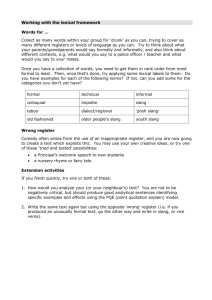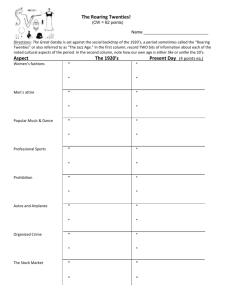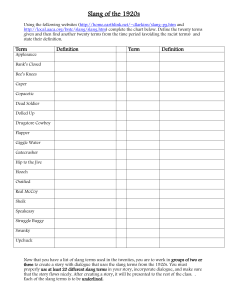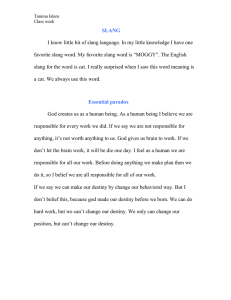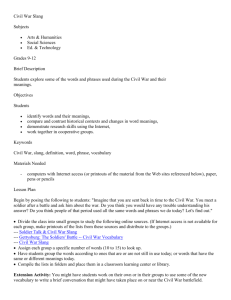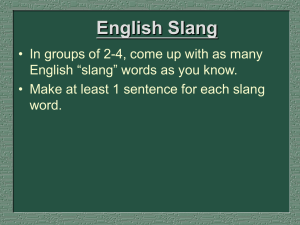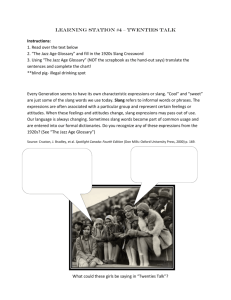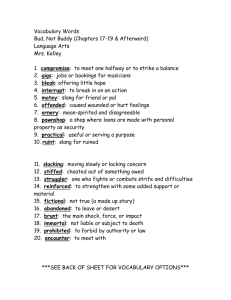American Slangs1
advertisement
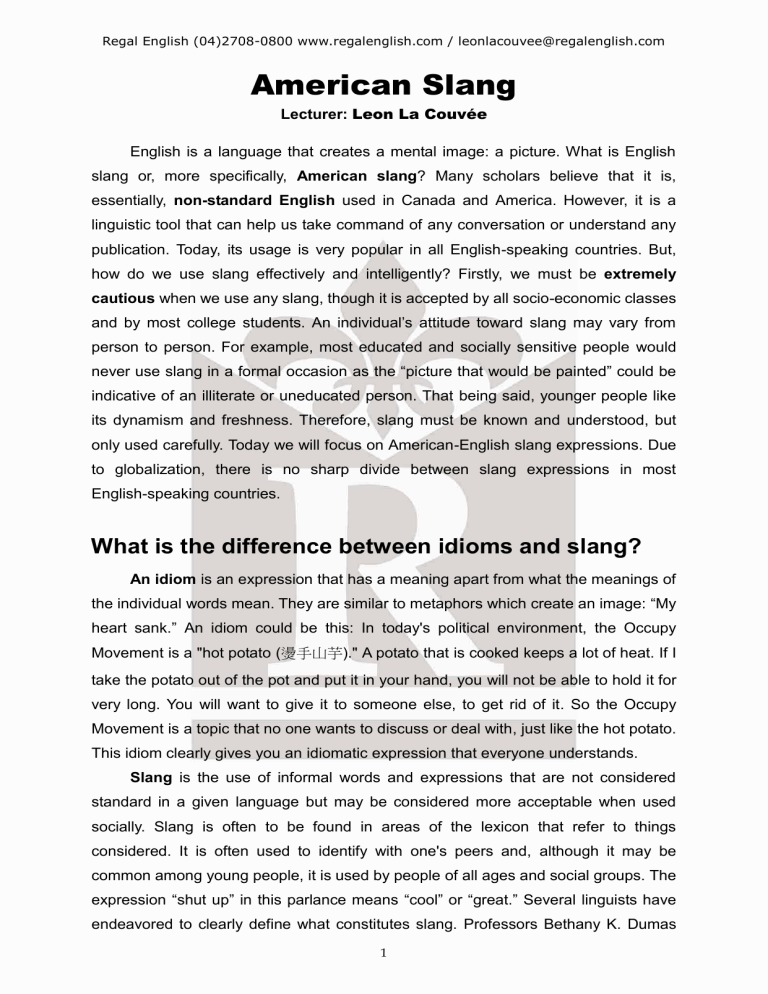
Regal English (04)2708-0800 www.regalenglish.com / leonlacouvee@regalenglish.com American Slang Lecturer: Leon La Couvé e English is a language that creates a mental image: a picture. What is English slang or, more specifically, American slang? Many scholars believe that it is, essentially, non-standard English used in Canada and America. However, it is a linguistic tool that can help us take command of any conversation or understand any publication. Today, its usage is very popular in all English-speaking countries. But, how do we use slang effectively and intelligently? Firstly, we must be extremely cautious when we use any slang, though it is accepted by all socio-economic classes and by most college students. An individual’s attitude toward slang may vary from person to person. For example, most educated and socially sensitive people would never use slang in a formal occasion as the “picture that would be painted” could be indicative of an illiterate or uneducated person. That being said, younger people like its dynamism and freshness. Therefore, slang must be known and understood, but only used carefully. Today we will focus on American-English slang expressions. Due to globalization, there is no sharp divide between slang expressions in most English-speaking countries. What is the difference between idioms and slang? An idiom is an expression that has a meaning apart from what the meanings of the individual words mean. They are similar to metaphors which create an image: “My heart sank.” An idiom could be this: In today's political environment, the Occupy Movement is a "hot potato (燙手山芋)." A potato that is cooked keeps a lot of heat. If I take the potato out of the pot and put it in your hand, you will not be able to hold it for very long. You will want to give it to someone else, to get rid of it. So the Occupy Movement is a topic that no one wants to discuss or deal with, just like the hot potato. This idiom clearly gives you an idiomatic expression that everyone understands. Slang is the use of informal words and expressions that are not considered standard in a given language but may be considered more acceptable when used socially. Slang is often to be found in areas of the lexicon that refer to things considered. It is often used to identify with one's peers and, although it may be common among young people, it is used by people of all ages and social groups. The expression “shut up” in this parlance means “cool” or “great.” Several linguists have endeavored to clearly define what constitutes slang. Professors Bethany K. Dumas 1 Regal English (04)2708-0800 www.regalenglish.com / leonlacouvee@regalenglish.com and Jonathan Lighter argue that an expression should be considered "true slang" if it meets at least two of the following criteria: It lowers "the dignity of formal or serious speech or writing," and it is likely to be considered a "glaring misuse of language." Its use implies familiarity with whatever is referred to, or with a group of people who are familiar with it and use the term. "It is a taboo term in ordinary discourse with people of a higher social status or greater responsibility." It replaces a well-known conventional synonym. This is done primarily to avoid the discomfort caused by the conventional item or by further elaboration. Idioms are phrases that exchange meaning: “It was a shoe-in.” A person does not literally have their shoe lodged in a door somewhere; the person is referring to their own being practically already accepted or integrated into a new particular grouping. Slang is a substitute for a definition: “That's bogus.” Bogus formally means fake or counterfeit, but the slang term of bogus means to be wrong in some aspect of behavior. "Doing someone bogus" means to have done wrong to that particular person. Idioms are terms distinctive to a people or to a district, community, or social class: they are peculiar. Slang is a substitute for a definition: they are distorted. Some scholars believe that the difference between the two forms of speech lies in their longevity: if a slang expression survives for a period of time, it becomes an idiom. Idioms are slowly welcomed and recognized by both the general public and, grudgingly, by the academies that oversee a language in any country or area: slang is not. It has to earn its way. The same is true with language. We have to be careful to keep an eye on where we are with what we say. What we think is "cool" today may slip away tomorrow. The usage of slang begins when we first learn English. English is effectively two languages: formal and informal. On the formal side, wherein we don’t know the person (the person is not my friend), we should restrict our conversation to discussions of the weather, sports and traffic. Once we have built a relationship we may embark on conversations based on relationships, religion, politics, and, much, much later, money. 2 Regal English (04)2708-0800 www.regalenglish.com / leonlacouvee@regalenglish.com Limiters “We are the picture that we paint.” This is a list of slang replies to simple questions about your recent activities or your health. Some expressions will limit your speech pattern: 1) A: How are you? B: So-so. This is a neutral expression meaning bland or mediocre. It is better to say: "Not bad.” 2) A: How have you been? B: Same old-same old. This suggests you are intellectually vapid. It is better to say: "Pretty good.” 3) A: What did you do yesterday? B: Nothing. This is logically impossible. It is better to say: "I spent a nice and quiet day.” 4) A: What did you do on the weekend? B: I “just” stayed at home. Here the inference is that I have no money, no friends, thus I was forced to remain in my house. It is better to say: "I stayed at home and did some reading” (even if it is not true). 5) A: How was your weekend? B: Nothing special. This suggests that my life is boring and uninteresting. It is better to say: "I stayed at home and worked on my project” (even if it is not true). 6) A: How do you like your work? B: So far so good. Here you suggest that your work could eventually have complications. It is better to say: "It’s been good” (even if it is not true). The Division of Slang The division of slang is, obviously, problematic. It can be arbitrarily divided into many assembled categories: youth slang, business slang, sports slang, slang 3 Regal English (04)2708-0800 www.regalenglish.com / leonlacouvee@regalenglish.com expressing frustration and slang indicating unrequited desire or vice, are some of the many divisions. We, however, suggest that the usage of slang is more helpful when placed in groups of judgment or decision: disagreement, intelligence, failure, stupidity of goodbyes, to name but a few. We are now going to play a short game to test your slang knowledge. 1. Talk to the hand. ________________ 21. wizard _________________________ 2. top banana ____________________ 22. uptight ________________________ 3. Knock it off! ___________________ 23, wiped out ______________________ 4. Who died and left you in charge? 24. dumb-bell ______________________ ______________________________ 25. yo-yo _________________________ 5. talk turkey ____________________ 26. Holy cow! ______________________ 6. That’s bad! ____________________ 27. railroad ________________________ 7. It sucks! ______________________ 28. cut one’s own throat ______________ 8. Shut up! ______________________ 29. have steam coming out of one’s ears 9. take the cake __________________ ______________________________ 10. Tell me about it. ________________ 30. rolling in money _________________ 11. My bad! ______________________ 31. eat humble pie __________________ 12. I blew it. ______________________ 32. hot potato ______________________ 13. Bug off! ______________________ 33. push the panic button _____________ 14. food for squirrels _______________ 34. peanuts _______________________ 15. upbeat ________________________ 35. bootlicker ______________________ 16. lights on, nobody home __________ 36. bone-breaker ___________________ 17. Don’t quit your day job. __________ 37. full of baloney __________________ 18. snowball’s chance in hell _________ 38. Is the pope Catholic? _____________ 19. hit the sack ____________________ 39. get cold feet ____________________ 20. I’ll give you a shout. _____________ 40. singing the blues ________________ 4 Regal English (04)2708-0800 www.regalenglish.com / leonlacouvee@regalenglish.com How to Introduce Yourself The “picture that you paint” of yourself, when you introduce yourself, will have irrevocable consequences. Fifty years ago, a person’s English accent represented one’s social status and education, coupled with dress and bearing. This is no longer the case. Now a person’s facial expression, clothing, grooming, hairstyle – pretty much anything we can physically see –plus one’s deferential speech pattern, have come to be the social determinates. When one is in a business situation, such as a client meeting or an interview, it is important to make a strong “first impression.” One way to create this first impression is through a positive and elegant introduction. The key to a stellar introduction is understated confidence: smile, speak clearly, and show interest. Avoid having moist hands at all cost. 13 Tips: How to Introduce Yourself Properly 1. Stand up: If you are sitting, stand up and look in the other person’s eyes. This shows interest and sincerity. (Many people believe that the western being is divided in two: the exterior physical body and the interior hidden soul. Aristotle believed that the eyes are “the windows to the soul”). 2. Extend your right hand: Keep an “arm’s length distance” when extending your hand to another person. In some cultures, being too close will make the other person uncomfortable. (Historically, the right hand could hold a knife or sword. Extending it without holding any weapon, therefore, showed your neutral or peaceful intention.) 3. Grip the other person’s hand firmly and gently shake: You are making a statement about your personal power. Grip the other person’s hand firmly, but do not squeeze it, especially with a person physically weaker than you are. Practice your handshake with a friend to get a feel for your strength. 4. Use your first and last names: Instead of saying, “Hi, I’m Jane.” Say, “Hello or good afternoon/evening. My name is Jane Smith.” You should always present yourself with your first and last names in an introduction. 5. If the other person has already introduced him or herself, repeat their name: “Peter/Mary, it’s so nice to meet you. I’m Jane Smith.” 6. If you introduce yourself first and then the other person introduces him or herself, repeat his or her name and say something nice: 5 Regal English (04)2708-0800 www.regalenglish.com / leonlacouvee@regalenglish.com “Peter/Mary, it’s a pleasure to meet you.” 7. If you meet a lot of people or you are a public figure, you may want to avoid certain sayings: Replace, “It’s nice to meet you.” Instead try, “It’s good to see you.” This way, if you’ve already met these people and don’t remember their names, you won’t offend them. There is nothing disrespectful in saying “It’s good to see you.” It sounds just as pleasant and inviting. (Try to never ask for a person’s name a second time. It suggests that you are disingenuous.) 8. You may include your business in your introduction: Depending on where you are or what is your purpose, you may need to include the name of your organization in your introduction. For example, if you’re attending a business conference, introducing yourself with your company makes sense. “Peter, it’s so nice to meet you. I’m Jane Smith from ABC Company.” 9. Consider including your title: Including your title in your introduction is a matter of personal preference and must be used with tact and caution. It is, however, a good idea in many situations, especially when you are introducing yourself to someone of equal social status. “Peter, I see from your trade-show badge that you are the president of DEF Company. It’s nice to meet you. I’m Jane Smith, the president of ABC Company. 10. Consider including your relationship: “Peter, it’s so nice to meet you. I’m Jane Smith. I’ll be your account executive on this project.” Or, “Peter, it’s so nice to meet you. I’m Jane Smith from ABC. I believe we have a mutual acquaintance. You’re a colleague of Jim Baker, one of our largest clients.” This is an excellent way to start a conversation. 11. Look at them: After introducing yourself, continue to look the person in the eye. This conveys confidence and sincerity. 12. Listen to them: Do not be frivolous. Listen to the other person’s introduction. Pay attention to their name (repeating it helps you remember it later), their company, important details and anything else they have to say. Listening and good memorization will assist in the personal picture that you paint. 13. Smile: An honest and genuine smile will disarm and warm the other person up to you. Remember, smiling is contagious. Positive people attract positive people. At Regal, we strive for excellence in all our material. It is compiled from numerous sources: Regal English, Regal Manners, Leon E. La Couvé e, Cody Wang, The New York Times, NPR, Wikipedia, and various other provinces. It is provided free of charge. 6
